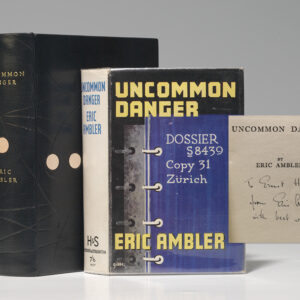Description
“THE FIRST COPY”: EXCEEDINGLY RARE PRESENTATION/ASSOCIATION FIRST EDITION OF CONAN DOYLE’S THE LOST WORLD, INSCRIBED BY HIM AT PUBLICATION WITH HIS DATE OF “OCT 16/12″—ALONG WITH HIS LAID-IN AUTOGRAPH CARD INSCRIBED BY HIM, “THAT COMPLETES THE BOOK. ACD”
CONAN DOYLE, Sir Arthur. The Lost World. London: Hodder and Stoughton, [1912]. Octavo, original pictorial navy cloth. Housed in a custom clamshell box.
First edition, ordinary-paper issue, of Conan Doyle’s “robust adventure story,” an exceptionally rare presentation copy inscribed by him promptly upon publication in his elegant cursive, to his beloved second wife Jean, “The first copy” [above the title] Jean Oct 16/12,” this copy accompanied by Conan Doyle’s autograph card, inscribed by him, “That completes the book. ACD.” Illustrated with eight tipped-in plates, including frontispiece photographic portrait of “the members of the exploring party.”
Conan Doyle was still married in the late 1890s when he met and fell in love with Jean Leckie, the woman who became his second wife in 1907 following the long illness and death of his first wife, Louisa. Near the time of this October 1912 inscription, Conan Doyle wrote: “‘The Lost World comes out on October 15th’… The book came out ten years to the month since his knighthood.” At the time Jean was pregnant with their third child, born that December. “Conan Doyle had a happy life with Jean and their three children, and his letters reflect it.” Doyle wrote his mother the month after the date of this inscription: “Jean is simply splendid… Everyone admires and loves her. The more I see of her the more wonderful does she seem” (Arthur Conan Doyle: A Life in Letters, 586-90). Jean also “took an interest in Doyle’s writing… her influence was apparently considerable” (Redmond, In Bed With Sherlock Holmes, 100). “When Conan Doyle killed off Holmes in The Final Problem… the actual device to explain away Holmes’ death was suggested to him by Jean” (Pascal, Arthur Conan Doyle, 107).
As early as 1889, Conan Doyle mused about writing “a Rider Haggardy kind of book… dedicated to all the naughty boys of the Empire.” By 1911 “he was writing it at last… inspired in part by local fossil evidences of prehistoric life”—including two fossilized iguanadon feet, a Stone Age flint arrowhead—and “by sentiments expressed at a May 1910 luncheon in honor of the Arctic explorer Robert Peary… [For] The Lost World, he turned to a barely explored region of the Amazon in South America; for as he said at Peary’s luncheon, ‘romance writers are a class of people who very much dislike being hampered by facts'” (Arthur Conan Doyle: A Life in Letters, 577-8). The book introduces Professor Challenger—a heroic scientist who “ranks second only to Sherlock Holmes in the Conan Doyle pantheon… [Conan Doyle] succeeds in painting vivid impressions of the prehistoric forest, now hushed and gloomy, now splashed with colorful, riotous life” (Fantasy: 100 Best Books 27). Conan Doyle partly based Challenger “on Professor [William] Rutherford whom [he] had known at Edinburgh and partly on himself” (Green & Gibson, 168-9). The Lost World, his “finest scientific romance, is a robust adventure story that brought a new sophistication to a standard boys’ book formula and provided the lost race story with its ultimate flourish” (Anatomy of Wonder II 354). Issued along with a large paper edition, no priority established. Without rare original dust jacket. Green & Gibson A37. Bookplate.
Interior fresh with light scattered foxing, only light rubbing to bright gilt-stamped cloth. A rare near-fine presentation copy.



